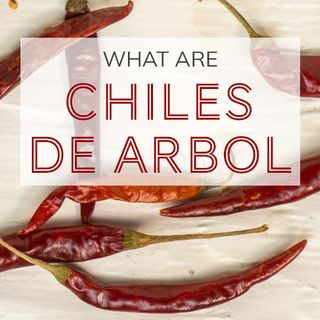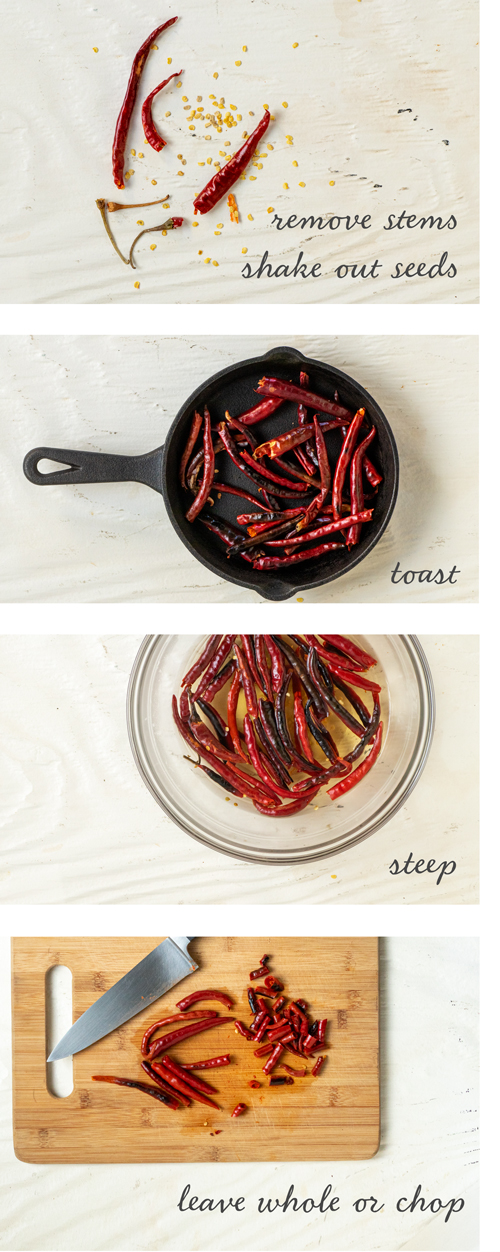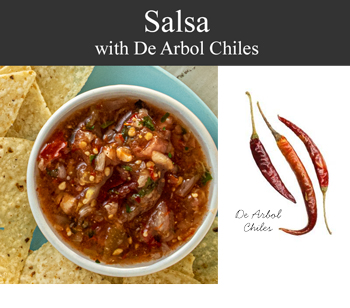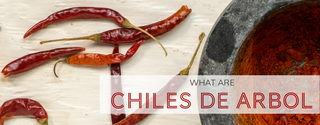What Are Chiles de Arbol

What Are Chiles de Arbol
De Arbol chiles, or chiles de Arbol, are small and slender chile peppers with a bold, spicy bite. Use de Arbol peppers in salsas and spice rubs and adds a playful punch to chili. While you may have seen this vibrant red chile strung together into decorative wreaths called ristras, this is the sort of chile you want to use to add a burst of heat to any dish.
These chiles are often confused with other long, thin chiles, like Tien Tsin or Japones. We have more than ten years of experience in chile pepper procurement and understand the differences between the varieties. Do you have de Arbol Chile questions? We have answers.
Table of Contents
All About Chiles de Arbol
The de Arbol Chile packs a surprising amount of heat into its small, thin-fleshed frame. Measuring 2-3 inches long and only about ½ inch at the shoulder, this chile delivers 15,000-30,000 Scoville Heat Units (SHU), making it a hot chile, though it’s on the lower end of the scale.
Chiles de Arbol, loosely translated as “chiles of the wood”, were given that name because of the pepper’s dark, woody cap and stem and not because they grow on trees. De Arbol Chiles grow on bushy plants, just like every other chile.
Because of their shape, de Arbol Chiles are also known as pico de Pajaro, “bird beak”, or cola de rata, “rat tail”. These chiles are called the same name whether they are fresh or dried.
These chiles originated and are a major agricultural force in Jalisco, one of the states located along Mexico’s western coast. De Arbol chiles are also commonly grown for commercial purposes in Aguascalientes, Nayarit, and Zacatecas to accommodate demand.
| Ingredients | De Arbol Chiles |
| Also Called | Chiles de Arbol, pico de pajaro, or cola de rata |
| Recommended Uses | Use in chili, salsa, sauces and in spice rubs and seasoning blends |
| Flavor Profile | Grassy, nutty, with a hint of smoke |
| Scoville Heat Units | 15,000-30,000 SHU |
| Botanical Name | Capsicum annuum |
| Cuisine | Mexican, American Southwest |
| How To Store | Airtight container in a cool, dark place |
| Shelf Life | 1-2 Years |
| Country of Origin | Mexico |
Chile de Arbol Flavor
Chiles de Arbol have a gentle flavor; they are grassy and nutty, with a touch of smoke winding around the top notes. This chile is bred more for heat than flavor, though their pleasant, nutty flavor is brought out even further when they are toasted in a dry pan.
Chile de Arbol Scoville Heat Units
We consider these on the lower end of the heat scale for hot chiles; they measure 15,000-30,000 SHU (Scoville Heat Units).
 How To Use Chile de Arbol
How To Use Chile de Arbol
We like to use De Arbol chiles in marinades, soups, and of course in salsas and hot sauces. Its long, thin size, heat, and flavor make it an ideal chile to infuse into honey, olive oil, tea, vinegar, and even vodka.
You can also grind them into powder. Once these chiles are powdered, you can use them in spice blends and cook them into a dish; their heat will mellow but permeate the entirety of a dish. You could also sprinkle powdered de Arbol Chile over dishes as they are finished. Used this way, they will provide heat pops throughout the dish rather than a more consistent heat level.
We recommend that regardless of how you intend to use these peppers, you toast them first in a dry pan over low to medium heat to coax out the most flavor.
How to Rehydrate Chile de Arbol
Rehydrating Chiles de Arbol peppers can take a little more work than other peppers, but it’s worth the effort. Plenty of online sources will advise you to use a standard rehydration process: toast the chiles over high heat for 30 seconds, cover with boiling water, steep for 20 minutes, and drain. This method will work if you’re in a hurry, but these chiles have a thicker skin and may not soften adequately with a short soak. In addition, this can result in unpleasant textures in dishes since the chiles may be leathery.
To ensure that your Chiles de Arbol are thoroughly rehydrated and ready to go, we recommend that you follow these steps:
1) Pull the woody caps off the de Arbol chiles and turn them over to pour out the seeds.
2) Toast de Arbol chiles in a dry pan over low to medium heat, stirring them constantly so they don’t burn. Remove them from heat once they become fragrant and start to brown.
3) Put them in a pot of boiling water and simmer over medium heat for 1 ½ - 2 hours.
4) Test them occasionally for tenderness. These chiles will not soften and will still offer a bit of resistance even in that long cooking time. You’ll know they’re done when bendable and squeezable, and the pepper walls give readily when you bite or pull at them.
5) At this point, they can be chopped and stirred into dishes as you would any other pepper or ground into puree to blend easily into sauces.
We don’t recommend saving this chile water for use once the chiles are finished cooking. De Arbol chile water is hot and bitter and doesn’t provide good flavors for sauces or soups.
How To Make de Arbol Powder
De Arbol chiles make a beautiful fresh powder, and this can be completed in under ten minutes.
First, remove the caps and turn the chiles over to pour out the seeds. Toast chiles in a dry pan over low to medium. Remove them from heat when they turn fragrant and darken; this should take between 3-5 minutes.
Let them sit for a minute or two until they are cool enough to handle. Break chiles into pieces and put them in a mortar and pestle or electric spice grinder. Grind to desired consistency. Use immediately, or store in an airtight container away from heat and direct sunlight.

Chile de Arbol Substitute
You can use Japones, Tien Tsin, and Pequin chiles as substitutes for any recipe calling for De Arbol chiles.
Japones chiles, 15,000-30,000 SHU, is roughly the same size and heat level as the de Arbol chile, but their flavor is almost non-existent.
Tien Tsin chiles can measure a bit higher in their heat range, spanning 10,000-60,000 SHU, so test these chiles before using them. They also have a faint flavor, though they can taste a little musty.
Pequin chiles share the nutty flavor quality that de Arbol chiles have but are twice as hot, measuring 40,000-58,000 SHU. Substitute with caution.
Where To Buy Chile de Arbol
You can find Chiles de Arbol in Mexican markets, grocery stores, and online retailers. All shopping environments have plusses and minuses.
When you visit a Mexican market, you’ll usually find the staff knowledgeable about their inventory. These shops tend to be smaller, so they don’t have as much clout when buying their chiles wholesale, resulting in higher prices passed to the consumer. It can also be challenging to know the age of a chile, which can impact its flavor.
Grocery stores can generally command better wholesale market prices, especially if their buyers purchase to supply chain stores. But grocery store buyers are often concerned with bulk over the accuracy and may end up supplying stores with mislabeled chiles, mainly if they appear close to other chiles.
When you go to buy chiles online, consider your retail source. Big-box online vendors offer convenience and often discounted shipping for members. Still, if they’re acting as a fulfillment center for a smaller company, there is no oversight regarding the quality or integrity of a product at the point of sale.
Online specialty shops usually have a large selection. Therefore, they have the expertise and knowledge to determine the difference between de Arbol Chiles and Japones Chiles.
Trustworthy shops also use procedures that guarantee their orders are filled correctly. In addition, well-run businesses have little turnover, which leads to a more knowledgeable staff, so there is a familiarity with products down the line, which will allow customers to get the chiles they want and need.

This quick and easy salsa showcases the nutty, mellow flavor of de Arbol Chiles, |
De Arbol Chiles require a little work if you want to cook with them successfully, but once you understand how to work with them, they provide pungent powder and spicy chunks of chile pepper to flavor a saute or a terrific puree that will embolden all your sauces. While the de Arbol Chile has some definite heat, it’s not completely overwhelming, and its mild flavor means it is versatile enough to use when making Thai food or want to heat your Indian cuisine.
Mexican dried chiles have influenced food around the world for hundreds of years. So take a look at Mexico’s peppers and start making a spicy impact in your kitchen, too.

